Detection of Pilot’s Mental Workload Using a Wireless EEG Headset in Airfield Traffic Pattern Tasks
Abstract
1. Introduction
- R1: Can we determine if the data accuracy collected by this EEG device is adequate for detecting the real-time mental workload of pilots?
- R2: Is there a suitable model that can identify pilots’ different MWL levels?
- R3: How can we determine the optimal input among all features?
- A real-time detection system for pilots’ MWL based on this WEEGH was proposed. This system had advantages such as low cost, low data redundancy, and fast computational speed. It also provided a direction for studying pilots’ MWL in real flight conditions or other real driving scenarios based on consumer-grade EEG devices.
- The impacts of different EEG features, based on this system, from different brain regions and different bands on MWL were investigated. The results of this study contribute to understanding the MWL mechanisms of pilots from the perspective of EEG and provide support for feature selection in future MWL-detecting research.
2. Materials and Methods
2.1. Participants
2.2. Flight Simulator
2.3. Wireless EEG Headset
2.4. Simulation Task and Procedure
- The aircraft starts taxiing along the runway. When the airspeed indicator reaches 55 knots, rotate the front wheels while maintaining a rate of climb (RoC) in upwind at 500 ft/min. When the altitude reaches 800 ft, participants can start to turn left;
- After the crosswind turn, maintain a track at 90° on the crosswind leg, and the distance of the crosswind leg should remain about 1.3 nautical miles;
- When the distance of the downwind leg exceeds the runway threshold by 1.3 nautical miles, the base leg begins. The altitude of the base leg should be maintained at 1100 ft. After the downwind leg, participants can begin to descend;
- The rate of approach should be maintained within 500 ft/min. And the altitude should be no more than 50 feet higher than the runway threshold when arrived.
2.5. Survey
2.6. EEG Processing
2.6.1. EEG Pre-Processing
2.6.2. Feature Extraction
2.7. Feature Selection
2.7.1. Statistical Analysis
2.7.2. Sequential Forward Floating Selection (SFFS)
2.8. Machine Learning Algorithms
2.9. Model Evaluation
3. Results
3.1. Survey for Mental Workload Identification
3.2. Mental Workload-Related Neuro-Physiological Behaviors
3.3. Feature Selection
3.3.1. Kruskal-Wallis Test
3.3.2. Sequential Forward Floating Selection
3.4. Performance Comparison
3.5. Performance Comparison of Various Classifiers
3.5.1. Performance Comparison of Feature Selection Algorithms
3.5.2. The Impact of EEG Features from Different Brain Regions on Mental Workload Detecting
4. Discussion
4.1. The Effectiveness of the Survey and the Experiment
4.2. Interpreting Physiological Patterns Related to Mental Workload Changes
4.3. Explaining the Works in Developing the Real-Time Mental Workload Detecting System
4.4. Practical Applications
5. Conclusions
Author Contributions
Funding
Institutional Review Board Statement
Data Availability Statement
Acknowledgments
Conflicts of Interest
References
- Ng, K.K.H.; Chen, C.-H.; Lee, C.K.M.; Jiao, J.R.; Yang, Z.-X. A Systematic Literature Review on Intelligent Automation: Aligning Concepts from Theory, Practice, and Future Perspectives. Adv. Eng. Inform. 2021, 47, 101246. [Google Scholar] [CrossRef]
- Ng, K.K.H.; Lee, C.K.M.; Chan, F.T.S.; Chen, C.-H.; Qin, Y. A Two-Stage Robust Optimisation for Terminal Traffic Flow Problem. Appl. Soft Comput. J. 2020, 89, 106048. [Google Scholar] [CrossRef]
- Dehais, F.; Lafont, A.; Roy, R.; Fairclough, S. A Neuroergonomics Approach to Mental Workload, Engagement and Human Performance. Front. Neurosci. 2020, 14, 268. [Google Scholar] [CrossRef]
- Zhang, C.; Liu, C.; Liu, H.; Jiang, C.; Fu, L.; Wen, C.; Cao, W. Incorporation of Pilot Factors into Risk Analysis of Civil Aviation Accidents from 2008 to 2020: A Data-Driven Bayesian Network Approach. Aerospace 2022, 10, 9. [Google Scholar] [CrossRef]
- Sciaraffa, N.; Aricò, P.; Borghini, G.; Flumeri, G.D.; Florio, A.D.; Babiloni, F. On the Use of Machine Learning for EEG-Based Workload Assessment: Algorithms Comparison in a Realistic Task. In Human Mental Workload: Models and Applications; Longo, L., Leva, M.C., Eds.; Communications in Computer and Information Science; Springer International Publishing: Cham, Switzerland, 2019; Volume 1107, pp. 170–185. ISBN 978-3-030-32422-3. [Google Scholar]
- Sha’Abani, M.; Fuad, N.; Jamal, N.; Ismail, M.F. KNN and SVM Classification for EEG: A Review. In Proceedings of the InECCE2019—5th International Conference on Electrical, Control & Computer Engineering, Kuantan, Pahang, Malaysia, 29 July 2019; Springer: Singapore, 2020; pp. 555–565. [Google Scholar]
- Li, Q.; Ng, K.K.H.; Yu, S.C.M.; Yiu, C.Y.; Lyu, M. Recognising Situation Awareness Associated with Different Workloads Using EEG and Eye-Tracking Features in Air Traffic Control Tasks. Knowl.-Based Syst. 2023, 260, 110179. [Google Scholar] [CrossRef]
- Lin, C.-T.; Chuang, C.-H.; Huang, C.-S.; Tsai, S.-F.; Lu, S.-W.; Chen, Y.-H.; Ko, L.-W. Wireless and Wearable EEG System for Evaluating Driver Vigilance. IEEE Trans. Biomed. Circuits Syst. 2014, 8, 165–176. [Google Scholar] [CrossRef]
- Jiao, Y.; Chen, X.; Sun, Z.; Fu, L.; Jiang, C.; Wen, C.; Zhang, X. Data-Driven Detection and Assessment for Urban Railway Transit Driver Fatigue in Real Work Conditions. Transp. Res. Rec. 2023, 2677, 1367–1375. [Google Scholar] [CrossRef]
- Borghini, G.; Astolfi, L.; Vecchiato, G.; Mattia, D.; Babiloni, F. Measuring Neurophysiological Signals in Aircraft Pilots and Car Drivers for the Assessment of Mental Workload, Fatigue and Drowsiness. Neurosci. Biobehav. Rev. 2014, 44, 58–75. [Google Scholar] [CrossRef] [PubMed]
- Gavaret, M.; Iftimovici, A.; Pruvost-Robieux, E. EEG: Current Relevance and Promising Quantitative Analyses. Rev. Neurol. 2023, 179, 352–360. [Google Scholar] [CrossRef]
- Niedermeyer, E.; da Silva, F.L. Electroencephalography: Basic Principles, Clinical Applications, and Related Fields; Lippincott Williams & Wilkins: Philadelphia, PA, USA, 2005; ISBN 0-7817-5126-8. [Google Scholar]
- Arico, P.; Borghini, G.; Di Flumeri, G.; Bonelli, S.; Golfetti, A.; Graziani, I.; Pozzi, S.; Imbert, J.-P.; Granger, G.; Benhacene, R.; et al. Human Factors and Neurophysiological Metrics in Air Traffic Control: A Critical Review. IEEE Rev. Biomed. Eng. 2017, 10, 250–263. [Google Scholar] [CrossRef]
- Gilmore, R. American-electroencephalographic-society guidelines in electroencephalography, evoked-potentials, and polysomnography. J. Clin. Neurophysiol. 1994, 11, 1–142. [Google Scholar] [CrossRef]
- Dasari, D.; Shou, G.; Ding, L. ICA-Derived EEG Correlates to Mental Fatigue, Effort, and Workload in a Realistically Simulated Air Traffic Control Task. Front. Neurosci. 2017, 11, 297. [Google Scholar] [CrossRef]
- Barry, R.; De Blasio, F. EEG Differences between Eyes-Closed and Eyes-Open Resting Remain in Healthy Ageing. Biol. Psychol. 2017, 129, 293–304. [Google Scholar] [CrossRef]
- Venables, L.; Fairclough, S. The Influence of Performance Feedback on Goal-Setting and Mental Effort Regulation. Motiv. Emot. 2009, 33, 63–74. [Google Scholar] [CrossRef]
- Bu, L.; Chen, C.-H.; Ng, K.K.H.; Zheng, P.; Dong, G.; Liu, H. A User-Centric Design Approach for Smart Product-Service Systems Using Virtual Reality: A Case Study. J. Clean. Prod. 2021, 280, 124413. [Google Scholar] [CrossRef]
- Pessoa, L. Understanding Brain Networks and Brain Organization. Phys. Life Rev. 2014, 11, 400–435. [Google Scholar] [CrossRef]
- Deng, P.-Y.; Qiu, X.-Y.; Tang, Z.; Zhang, W.-M.; Zhu, L.-M.; Ren, H.; Zhou, G.-R.; Sheng, R.S. Detecting Fatigue Status of Pilots Based on Deep Learning Network Using EEG Signals. IEEE Trans. Cogn. Dev. Syst. 2020, 13, 575–585. [Google Scholar]
- Cohen, M. Where Does EEG Come from and What Does It Mean? Trends Neurosci. 2017, 40, 208–218. [Google Scholar] [CrossRef]
- Yiu, C.Y.; Ng, K.K.H.; Li, X.; Zhang, X.; Li, Q.; Lam, H.S.; Chong, M.H. Towards Safe and Collaborative Aerodrome Operations: Assessing Shared Situational Awareness for Adverse Weather Detection with EEG-Enabled Bayesian Neural Networks. Adv. Eng. Inform. 2022, 53, 101698. [Google Scholar] [CrossRef]
- Dechantsreiter, E.; Padberg, F.; Morash, A.; Kumpf, U.; Nguyen, A.; Menestrina, Z.; Windel, F.; Burkhardt, G.; Goerigk, S.; Morishita, T. Examining the Synergistic Effects of a Cognitive Control Video Game and a Home-Based, Self-Administered Non-Invasive Brain Stimulation on Alleviating Depression: The DiSCoVeR Trial Protocol. Eur. Arch. Psychiatry Clin. Neurosci. 2023, 273, 85–98. [Google Scholar] [CrossRef] [PubMed]
- Farooq, A.S.; Zhang, P. A Comprehensive Review on the Prospects of Next-Generation Wearable Electronics for Individualized Health Monitoring, Assistive Robotics, and Communication. Sens. Actuators A Phys. 2022, 344, 113715. [Google Scholar] [CrossRef]
- Zabcikova, M.; Koudelkova, Z.; Jasek, R. Examining the Efficiency of Emotiv Insight Headset by Measuring Different Stimuli. WSEAS Trans. Appl. Theor. Mech. 2019, 14, 235–242. [Google Scholar]
- LaRocco, J.; Le, M.D.; Paeng, D.-G. A Systemic Review of Available Low-Cost EEG Headsets Used for Drowsiness Detection. Front. Neuroinform. 2020, 14, 553352. [Google Scholar] [CrossRef]
- Dehais, F.; Duprès, A.; Blum, S.; Drougard, N.; Scannella, S.; Roy, R.N.; Lotte, F. Monitoring Pilot’s Mental Workload Using ERPs and Spectral Power with a Six-Dry-Electrode EEG System in Real Flight Conditions. Sensors 2019, 19, 1324. [Google Scholar] [CrossRef]
- Neumann, T.; Baum, A.K.; Baum, U.; Deike, R.; Feistner, H.; Scholz, M.; Hinrichs, H.; Robra, B. Assessment of the Technical Usability and Efficacy of a New Portable Dry-Electrode EEG Recorder: First Results of the HOMEONE Study. Clin. Neurophysiol. 2019, 130, 2076–2087. [Google Scholar] [CrossRef] [PubMed]
- Lakhan, P.; Banluesombatkul, N.; Changniam, V.; Dhithijaiyratn, R.; Leelaarporn, P.; Boonchieng, E.; Hompoonsup, S.; Wilaiprasitporn, T. Consumer Grade Brain Sensing for Emotion Recognition. IEEE Sens. J. 2019, 19, 9896–9907. [Google Scholar] [CrossRef]
- Niso, G.; Romero, E.; Moreau, J.T.; Araujo, A.; Krol, L.R. Wireless EEG: A Survey of Systems and Studies. NeuroImage 2023, 269, 119774. [Google Scholar] [CrossRef]
- Lin, C.-T.; Chang, C.-J.; Lin, B.-S.; Hung, S.-H.; Chao, C.-F.; Wang, I.-J. A Real-Time Wireless Brain–Computer Interface System for Drowsiness Detection. IEEE Trans. Biomed. Circuits Syst. 2010, 4, 214–222. [Google Scholar] [CrossRef] [PubMed]
- Dunbar, J.; Gilbert, J.E.; Lewis, B. Exploring Differences between Self-Report and Electrophysiological Indices of Drowsy Driving: A Usability Examination of a Personal Brain-Computer Interface Device. J. Saf. Res. 2020, 74, 27–34. [Google Scholar] [CrossRef] [PubMed]
- Hart, S.G.; Staveland, L.E. Development of NASA-TLX (Task Load Index): Results of Empirical and Theoretical Research. In Advances in Psychology; Elsevier: Amsterdam, The Netherlands, 1988; Volume 52, pp. 139–183. [Google Scholar]
- Mansikka, H.; Virtanen, K.; Harris, D. Comparison of NASA-TLX Scale, Modified Cooper-Harper Scale and Mean Inter-Beat Interval as Measures of Pilot Mental Workload during Simulated Flight Tasks. Ergonomics 2019, 62, 246–254. [Google Scholar] [CrossRef]
- Khan, M.A.; Pierre, J.W. Detection of Periodic Forced Oscillations in Power Systems Using Multitaper Approach. IEEE Trans. Power Syst. 2018, 34, 1086–1094. [Google Scholar] [CrossRef]
- Hjorth, B. EEG Analysis Based on Time Domain Properties. Electroencephalogr. Clin. Neurophysiol. 1970, 29, 306–310. [Google Scholar] [CrossRef] [PubMed]
- Richman, J.S.; Moorman, J.R. Physiological Time-Series Analysis Using Approximate Entropy and Sample Entropy. Am. J. Physiol.-Heart Circ. Physiol. 2000, 278, H2039–H2049. Available online: https://journals.physiology.org/doi/full/10.1152/ajpheart.2000.278.6.H2039?view=long&pmid=10843903 (accessed on 10 May 2023). [CrossRef]
- Pincus, S.M.; Gladstone, I.M.; Ehrenkranz, R.A. A Regularity Statistic for Medical Data Analysis|SpringerLink. Available online: https://link.springer.com/article/10.1007/BF01619355 (accessed on 10 May 2023).
- McCrum-Gardner, E. Which Is the Correct Statistical Test to Use? Br. J. Oral Maxillofac. Surg. 2008, 46, 38–41. [Google Scholar] [CrossRef]
- Bemister-Buffington, J.; Wolf, A.J.; Raschka, S.; Kuhn, L.A. Machine Learning to Identify Flexibility Signatures of Class A GPCR Inhibition. Biomolecules 2020, 10, 454. [Google Scholar] [CrossRef] [PubMed]
- Qiu, Z.; Jin, J.; Lam, H.-K.; Zhang, Y.; Wang, X.; Cichocki, A. Improved SFFS Method for Channel Selection in Motor Imagery Based BCI. Neurocomputing 2016, 207, 519–527. [Google Scholar] [CrossRef]
- Li, S.; Zhou, W.; Yuan, Q.; Geng, S.; Cai, D. Feature Extraction and Recognition of Ictal EEG Using EMD and SVM. Comput. Biol. Med. 2013, 43, 807–816. [Google Scholar] [CrossRef]
- Jia, B.-B.; Zhang, M.-L. Multi-Dimensional Classification via KNN Feature Augmentation. Pattern Recognit. 2020, 106, 107423. [Google Scholar] [CrossRef]
- Xiao, J. SVM and KNN Ensemble Learning for Traffic Incident Detection. Phys. A Stat. Mech. Appl. 2019, 517, 29–35. [Google Scholar] [CrossRef]
- Kästle, J.L.; Anvari, B.; Krol, J.; Wurdemann, H.A. Correlation between Situational Awareness and EEG Signals. Neurocomputing 2021, 432, 70–79. [Google Scholar] [CrossRef]
- Speiser, J.L.; Miller, M.E.; Tooze, J.; Ip, E. A Comparison of Random Forest Variable Selection Methods for Classification Prediction Modeling. Expert Syst. Appl. 2019, 134, 93–101. [Google Scholar] [CrossRef]
- Zhang, X.; Mahadevan, S. Bayesian Neural Networks for Flight Trajectory Prediction and Safety Assessment. Decis. Support Syst. 2020, 131, 113246. [Google Scholar] [CrossRef]
- Mou, L.; Liang, L.; Gao, Z.; Wang, X. A Multi-Scale Anomaly Detection Framework for Retinal OCT Images Based on the Bayesian Neural Network. Biomed. Signal Process. Control 2022, 75, 103619. [Google Scholar] [CrossRef]
- Bernhardt, K.A.; Poltavski, D.; Petros, T.; Ferraro, F.R.; Jorgenson, T.; Carlson, C.; Drechsel, P.; Iseminger, C. The Effects of Dynamic Workload and Experience on Commercially Available EEG Cognitive State Metrics in a High-Fidelity Air Traffic Control Environment. Appl. Ergon. 2019, 77, 83–91. [Google Scholar] [CrossRef]
- Gupta, V.; Priya, T.; Yadav, A.K.; Pachori, R.B.; Rajendra Acharya, U. Automated Detection of Focal EEG Signals Using Features Extracted from Flexible Analytic Wavelet Transform. Pattern Recognit. Lett. 2017, 94, 180–188. [Google Scholar] [CrossRef]
- Ayinde, B.O.; Inanc, T.; Zurada, J.M. Redundant Feature Pruning for Accelerated Inference in Deep Neural Networks. Neural Netw. 2019, 118, 148–158. [Google Scholar] [CrossRef]
- Taheri Gorji, H.; Wilson, N.; VanBree, J.; Hoffmann, B.; Petros, T.; Tavakolian, K. Using Machine Learning Methods and EEG to Discriminate Aircraft Pilot Cognitive Workload during Flight. Sci. Rep. 2023, 13, 2507. [Google Scholar] [CrossRef] [PubMed]
- Grier, R.A. How High Is High? A Meta-Analysis of NASA-TLX Global Workload Scores. Proc. Hum. Factors Ergon. Soc. Annu. Meet. 2015, 59, 1727–1731. [Google Scholar] [CrossRef]
- Bröhl, F.; Kayser, C. Delta/Theta Band EEG Differentially Tracks Low and High Frequency Speech-Derived Envelopes. NeuroImage 2021, 233, 117958. [Google Scholar] [CrossRef] [PubMed]
- Tanaka, K. Temporal Lobe. In International Encyclopedia of the Social & Behavioral Sciences; Smelser, N.J., Baltes, P.B., Eds.; Pergamon: Oxford, UK, 2001; pp. 15595–15599. ISBN 978-0-08-043076-8. [Google Scholar]
- Al Hammadi, A.Y.; Yeun, C.Y.; Damiani, E.; Yoo, P.D.; Hu, J.; Yeun, H.K.; Yim, M.-S. Explainable Artificial Intelligence to Evaluate Industrial Internal Security Using EEG Signals in IoT Framework. Ad Hoc Netw. 2021, 123, 102641. [Google Scholar] [CrossRef]
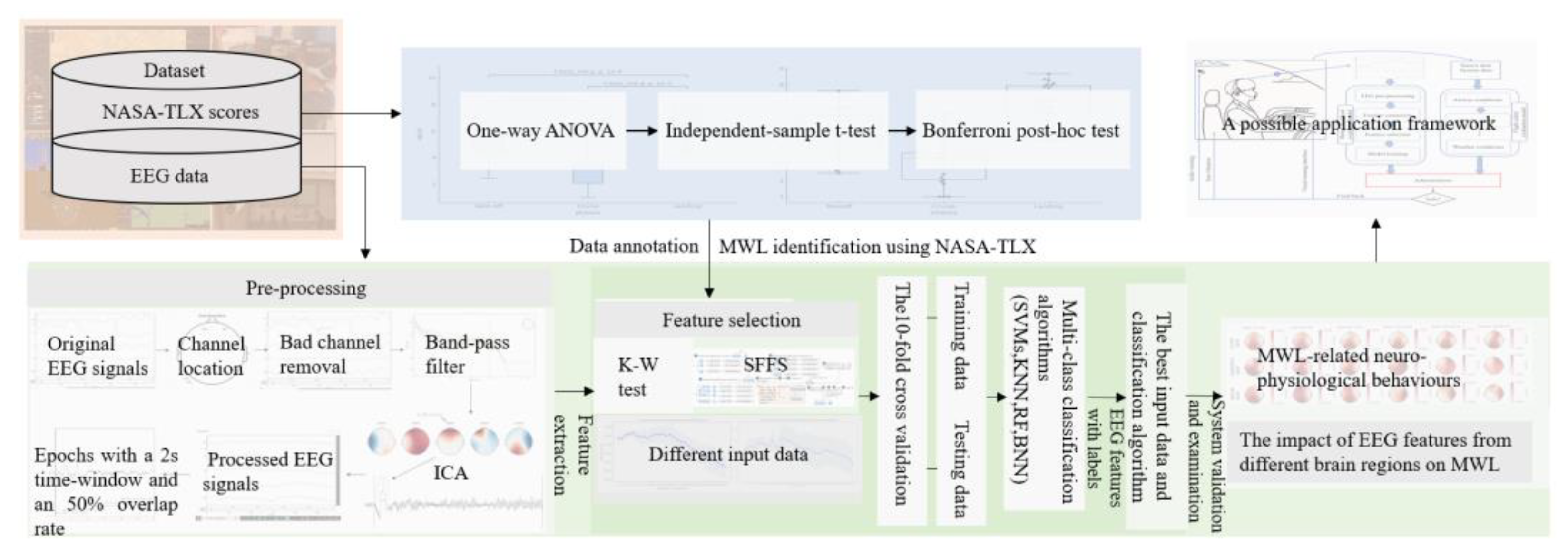
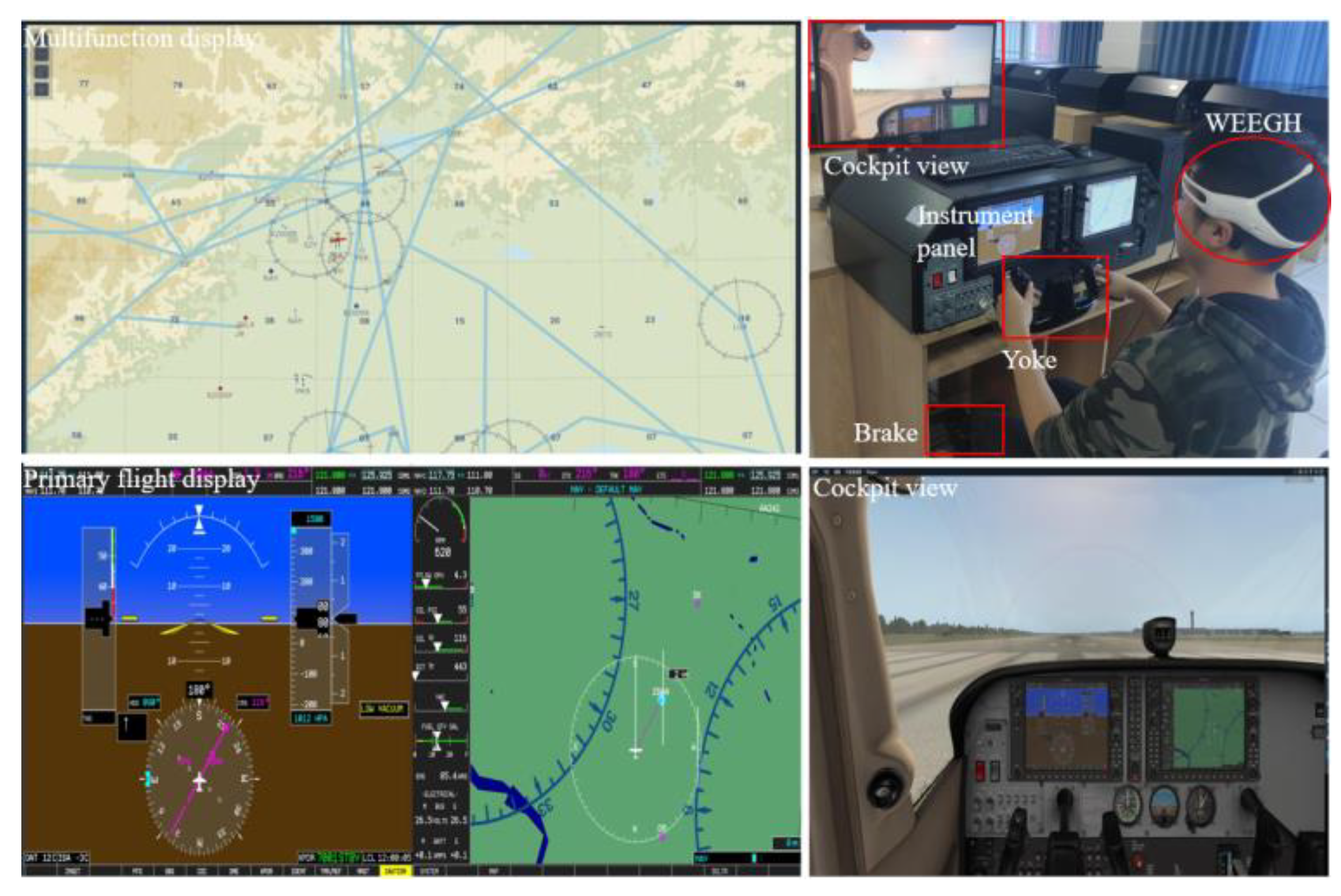


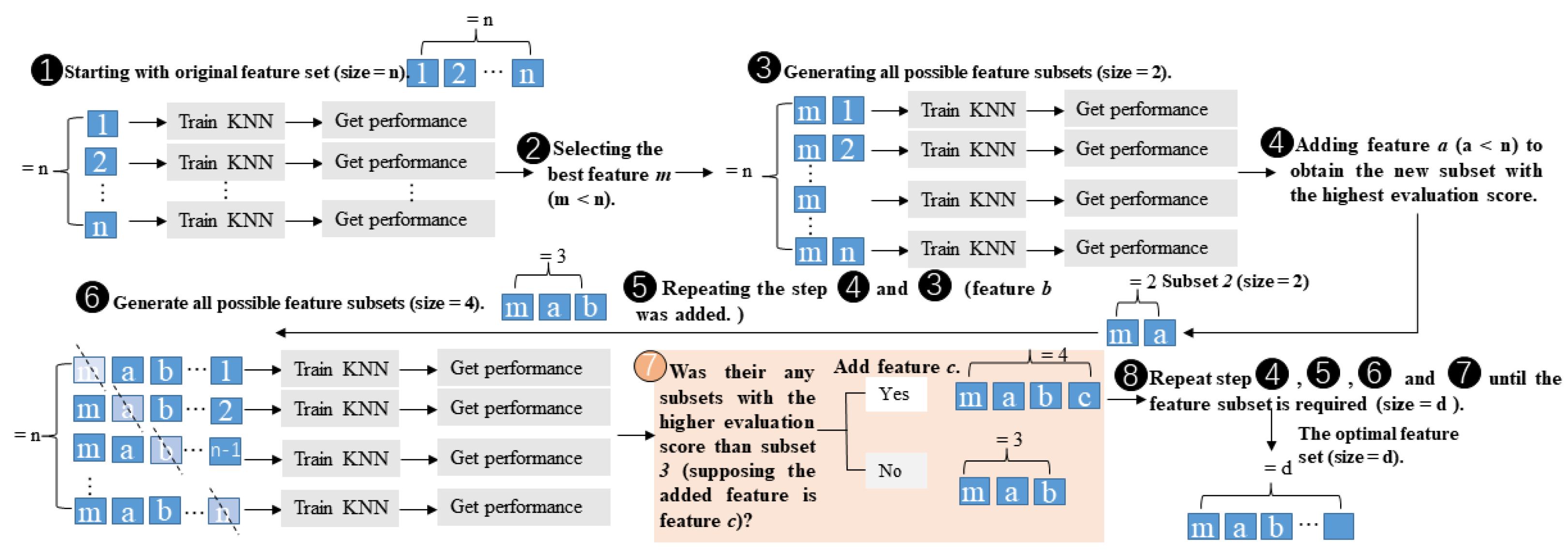
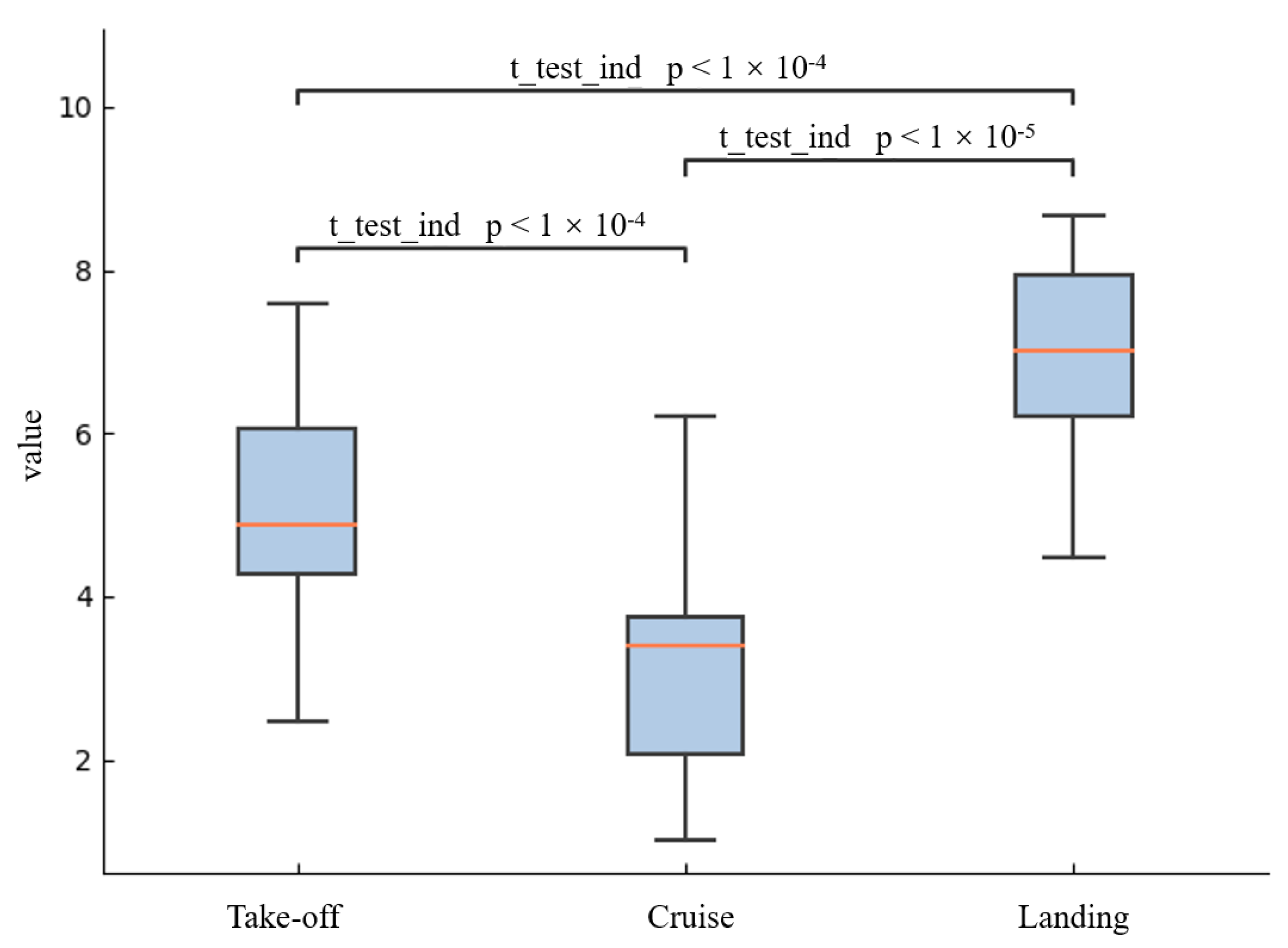

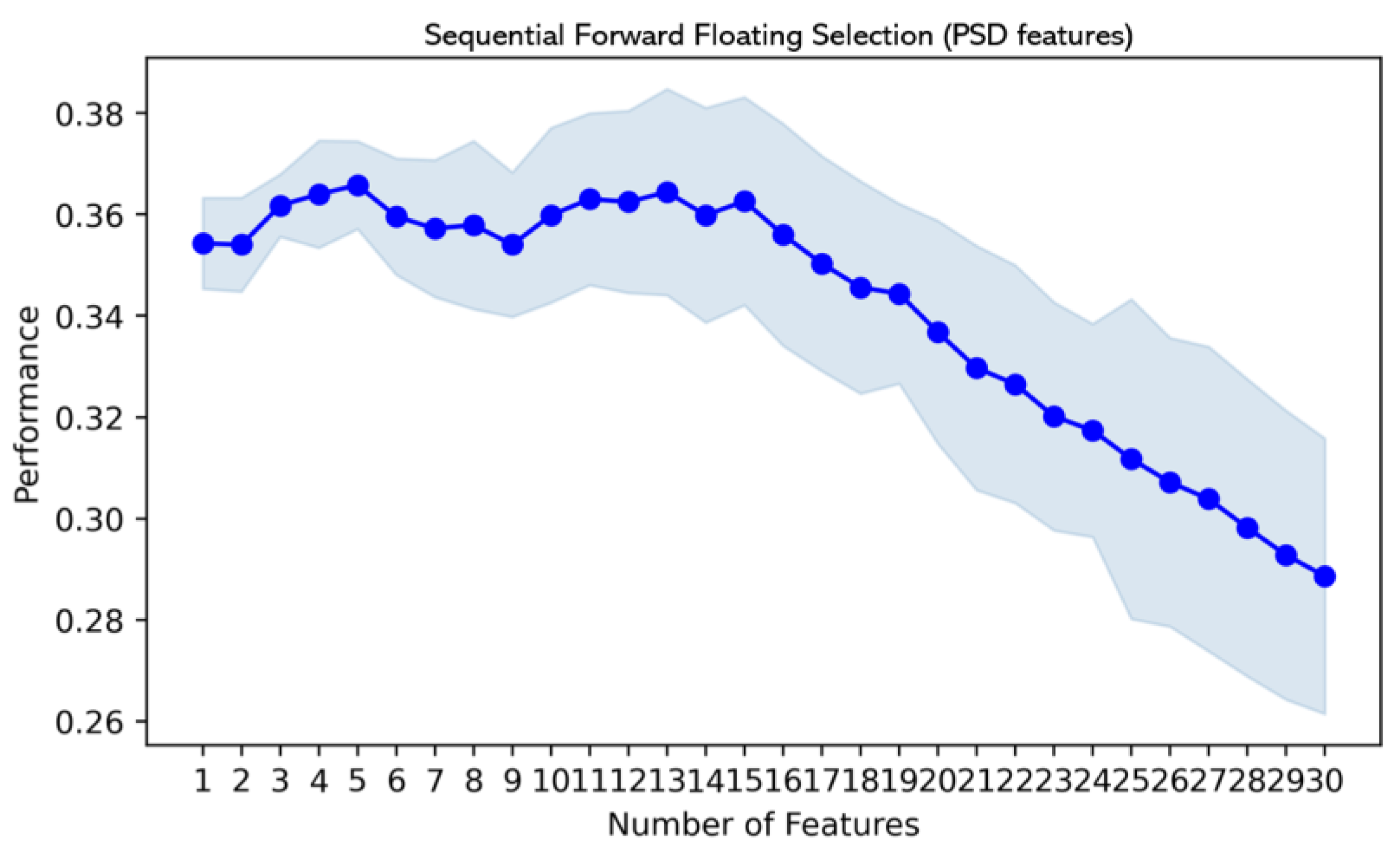

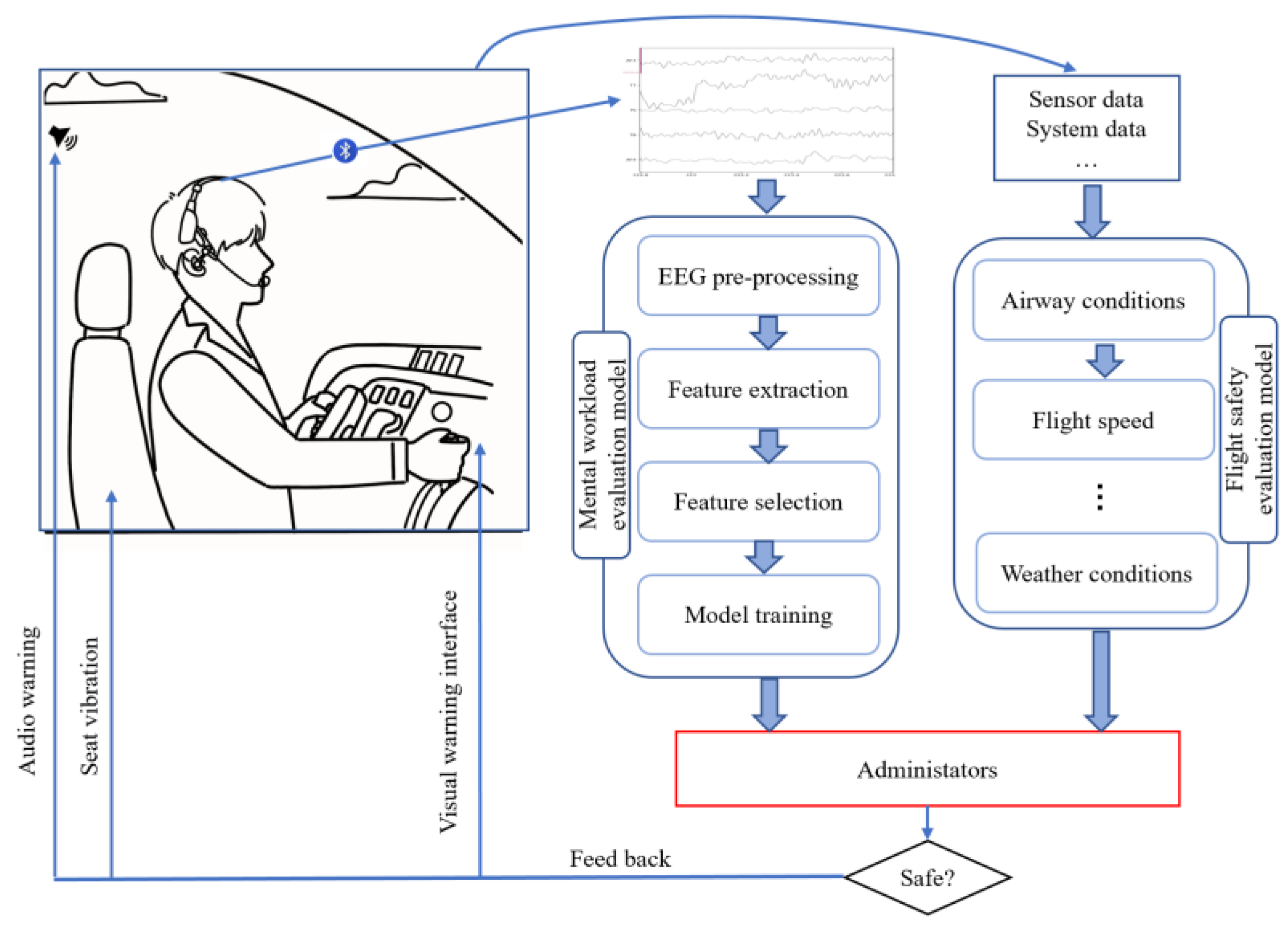
| Domain | Features | Unit | Description |
|---|---|---|---|
| Frequency | Power spectral density (PSD) | μv2/Hz | power spectral density of oscillations at a specific frequency band in a particular brain region of a participant during a single trial. |
| Time | Mean | μv | a measure of central tendency and provides information about the overall level of activity in the EEG signal. |
| Variance (vari) | μv2 | providing information about the spread of the data and used to measure signal variability in EEG analysis. | |
| Standard deviation (std) | μv | providing information about the degree of variability in the data, it is used to measure signal variability in EEG analysis. | |
| Peak–to–peak amplitude (ptp-amp) | μv | a measure of the difference between the highest and lowest points of a single waveform in the EEG signal. | |
| Skewness | - | a measure of the asymmetry of the probability distribution of recorded EEG data about its mean. | |
| Kurtosis | - | a measure of the “tailedness” of the probability distribution of recorded EEG data. | |
| Root—mean squared (rms) value | μv | the root—mean squared value of recorded EEG data. | |
| Zero crossing (zc) | - | a point where the EEG signal changes sign in its waveform. | |
| Hjorth mobility (hm) | μv/Hz | represents the mean frequency or the proportion of standard deviation of the power spectrum [36]. | |
| Hjorth complexity (hc) | - | indicates how similar the shape of a signal is to a pure sine wave, and gives an estimation of the bandwidth of the signal [36]. | |
| Non-linear | Sample entropy (se) | - | used for assessing the complexity of EEG time-series signals [37]. |
| Approximate entropy (ae) | - | a technique used to quantify the amount of regularity and the unpredictability of fluctuations over time-series data [38]. |
| Features | p (AF4) | p (AF3) | p (T7) | p (T8) | p (Pz) |
|---|---|---|---|---|---|
| δ | 0.000 ** | 0.000 ** | 0.002 ** | 0.002 ** | 0.192 |
| θ | 0.004 ** | 0.005 ** | 0.015 * | 0.023 * | 0.396 |
| α | 0.000 ** | 0.236 | 0.194 | 0.401 | 0.000 ** |
| β1 | 0.000 ** | 0.008 ** | 0.223 | 0.257 | 0.000 ** |
| β2 | 0.000 ** | 0.000 ** | 0.004 ** | 0.172 | 0.000 ** |
| γ | 0.000 ** | 0.000 ** | 0.002 ** | 0.029 * | 0.000 ** |
| Mean | 0.860 | 0.887 | 0.502 | 0.877 | 0.930 |
| Variance | 0.000 ** | 0.000 ** | 0.008 ** | 0.252 | 0.392 |
| Standard deviation | 0.000 ** | 0.000 ** | 0.008 ** | 0.252 | 0.392 |
| Peak–to–peak amplitude | 0.000 ** | 0.001 ** | 0.009 ** | 0.426 | 0.377 |
| Skewness | 0.741 | 0.000 ** | 0.412 | 0.996 | 0.080 |
| Kurtosis | 0.713 | 0.780 | 0.185 | 0.004 ** | 0.343 |
| Root–mean squared value | 0.000 ** | 0.001 ** | 0.000 ** | 0.209 | 0.187 |
| Zero crossing | 0.008 ** | 0.000 ** | 0.005 ** | 0.144 | 0.053 |
| Hjorth mobility | 0.557 | 0.000 ** | 0.024 * | 0.001 ** | 0.038 * |
| Hjorth complexity | 0.323 | 0.000 ** | 0.003 ** | 0.000 ** | 0.147 |
| Sample entropy | 0.784 | 0.000 ** | 0.043 * | 0.000 ** | 0.020 * |
| Approximate entropy | 0.493 | 0.000 ** | 0.007 ** | 0.000 ** | 0.008 ** |
| Performance | PSD Features | Calculative Features | ||||||||
|---|---|---|---|---|---|---|---|---|---|---|
| Classifiers | KNN | RF | SVM-L | SVM-R | SVM-P | KNN | RF | SVM-L | SVM-R | SVM-P |
| Accuracy | 87.57 ± 0.72 | 86.52 ± 0.95 | 66.48 ± 1.22 | 71.35 ± 1.17 | 67.85 ± 1.19 | 79.55 ± 0.86 | 82.56 ± 1.33 | 64.59 ± 1.21 | 70.43 ± 1.41 | 68.20 ± 1.26 |
| Precision | 80.47 ± 0.92 | 88.35 ± 1.85 | 22.16 ± 0.41 | 58.11 ± 14.67 | 55.53 ± 12.25 | 72.43 ± 0.97 | 86.64 ± 1.79 | 22.24 ± 0.76 | 77.46 ±17.03 | 68.66 ± 13.38 |
| Recall | 72.76 ± 1.40 | 65.94 ± 1.87 | 33.30 ± 0.01 | 41.22 ± 1.01 | 35.37 ± 0.44 | 65.40 ± 1.01 | 59.78 ± 1.98 | 33.30 ± 0.01 | 44.34 ± 1.29 | 40.79 ± 0.64 |
| F1 score | 75.73 ± 1.21 | 70.57 ± 2.28 | 26.62 ± 0.29 | 40.56 ± 1.45 | 30.96 ± 0.76 | 67.09 ± 1.43 | 65.18 ± 3.01 | 26.67 ± 0.33 | 46.35 ± 1.84 | 40.87 ± 1.18 |
| Feature Sets | Contained Features |
|---|---|
| Input data 1 | AF4-δ, AF4-θ, AF4-α, AF4-β1, AF4-β2, AF4-γ, AF3-δ, AF3-θ, AF3-β1, AF3-β2, AF3-γ, T7-δ, T7-β2, T7-γ, T8-δ, Pz-α, Pz-β1, Pz-β2, Pz-γ |
| Input data 2 | AF4-δ, AF4-θ, AF4-α, AF4-β1, AF4-β2, AF4-γ, AF3-δ, AF3-θ, AF3-β1, AF3-β2, AF3-γ, T7-δ, T7-θ, T7-β2, T7-γ, T8-δ, T8-θ, T8-γ, Pz-α, Pz-β1, Pz-β2, Pz-γ |
| Input data 3 | AF4-vari, AF4-std, AF4-ptp-amp, AF4-rms, AF4-ae, AF3-vari, AF3-std, AF3-ptp-amp, AF3-skewness, AF3-rms, AF3-ae, AF3-se, AF-3zc, AF3-hm, AF3-hc, T7-vari, T7-std, T7-ptp-amp, T7-rms, T7-ae, T7-se, T7-zc, T7-hm, T7-hc, T8-kurtosis, T8-se, T8-zc, T8-hm, T8-hc, Pz-hm, Pz-hc |
| Input data 4 | Input data 3 and Pz-skewness and Pz-se |
| Input data 5 | AF4-α, AF4-β2, T7-δ, Pz-α, Pz-β1 |
| Input data 6 | AF4-δ, AF4-β1, AF4-γ, AF3-δ, AF3-α, AF3-β1, AF3-β2, AF3-γ, Pz-θ, Pz-α, Pz-β1, Pz-β2, Pz-γ |
| Input data 7 | AF4-vari, AF4-std, AF4-ptp-amp, AF4-rms, AF4-ae, AF3-vari, AF3-std, AF3-ptp-amp, AF3-skewness, AF3-rms, AF3-ae, AF3-se, AF3-zc, AF3-hm, AF3-hc, T7-vari, T7-std, T7-ptp-amp, T7-rms, T7-ae, T7-se, T7-zc, T7-hm, T7-hc, T8-se, T8-zc, T8-hm, T8-hc, Pz-hm, Pz-hc |
| Input data 8 | All PSD features |
| Input data 9 | All features |
| Performance | Algorithm | Input Data 1 | Input Data 2 | Input Data 3 | Input Data 4 | Input Data 5 | Input Data 6 | Input Data 7 |
|---|---|---|---|---|---|---|---|---|
| Accuracy | KNN | 85.50 ± 0.56 | 86.3 ± 0.9 | 80.52 ± 2.15 | 80.11 ± 2.21 | 83.15 ± 0.65 | 85.01 ± 0.81 | 79.46 ± 1.58 |
| RF | 85.99 ± 0.61 | 87.3 ± 0.5 * | 81.54 ± 0.99 | 81.86 ± 1.02 * | 83.54 ± 0.52 | 84.85 ± 0.69 | 81.29 ± 0.71 | |
| Precision | KNN | 79.24 ± 2.21 | 80.8 ± 1.0 | 70.47 ± 3.09 | 70.04 ± 4.02 | 72.85 ± 2.11 | 75.48 ± 1.46 | 68.60 ± 2.72 |
| RF | 87.92 ± 1.56 | 88.5 ± 1.6 * | 85.18 ± 2.54 | 86.27 ± 1.19 * | 84.08 ± 1.35 | 87.86 ± 1.45 | 85.08 ± 2.34 | |
| Recall | KNN | 72.08 ± 1.71 | 72.36 ± 0.89 * | 61.79 ± 4.26 | 62.98 ± 4.24 * | 67.75 ± 1.29 | 69.21 ± 1.70 | 61.58 ± 1.33 |
| RF | 66.03 ± 1.81 | 66.57 ± 1.05 | 58.35 ± 1.67 | 59.05 ± 1.10 | 63.62 ± 1.28 | 63.42 ± 1.14 | 57.83 ± 1.19 | |
| F1 score | KNN | 74.83 ± 1.75 | 75.20 ± 0.95 * | 64.45 ± 4.47 | 64.69 ± 4.41 * | 69.84 ± 1.51 | 71.64 ± 1.66 | 63.97 ± 1.61 |
| RF | 70.67 ± 2.36 | 71.35 ± 1.24 | 63.06 ± 2.19 | 64.06 ± 1.27 | 68.45 ± 1.57 | 67.87 ± 1.60 | 62.65 ± 1.64 |
| Performance | Algorithm | Input Data 8 | Input Data 9 | Input Data 10 |
|---|---|---|---|---|
| Accuracy | KNN | 87.57 ± 0.72 * | 82.80 ± 2.20 | 81.34 ± 2.15 |
| RF | 86.52 ± 0.95 | 83.70 ± 0.68 | 82.98 ± 0.93 | |
| Precision | KNN | 80.47 ± 0.92 | 76.30 ± 3.33 | 72.44 ± 5.39 |
| RF | 88.35 ± 1.85 * | 87.60 ± 1.67 | 88.20 ± 1.43 | |
| Recall | KNN | 72.76 ± 1.40 * | 67.86 ± 1.90 | 65.67 ± 1.34 |
| RF | 65.94 ± 1.87 | 62.15 ± 1.66 | 60.50 ± 1.38 | |
| F1 | KNN | 75.73 ± 1.21 * | 70.76 ± 2.02 | 67.82 ± 2.63 |
| RF | 70.57 ± 2.28 | 67.41 ± 2.12 | 65.66 ± 1.87 |
| Region | Inputs | Accuracy | Precision | Recall | F1 Score |
|---|---|---|---|---|---|
| Frontal (AF4, AF3) | δ | 80.49 ± 0.38 | 66.82 ± 0.94 | 62.74 ± 0.80 | 64.42 ± 0.78 |
| θ | 80.03 ± 0.88 | 65.94 ± 1.63 | 61.40 ± 0.94 | 63.16 ± 1.15 | |
| α | 79.88 ± 0.78 | 65.70 ± 1.69 | 61.06 ± 0.98 | 62.93 ± 1.22 | |
| β1 | 79.31 ± 1.06 | 65.17 ± 1.86 | 60.52 ± 1.70 | 62.32 ± 1.72 | |
| β2 | 80.24 ± 0.79 | 66.91 ± 1.38 | 61.90 ± 1.15 | 63.83 ± 1.12 | |
| γ | 79.40 ± 0.81 | 65.60 ± 2.08 | 60.96 ± 1.29 | 62.76 ± 1.53 | |
| mix | 84.35 ± 0.85 | 74.91 ± 1.71 | 68.17 ± 1.53 | 70.74 ± 1.58 | |
| Temporal (T7, T8) | δ | 80.97 ± 0.61 | 68.46 ± 1.44 | 63.31 ± 1.14 | 65.32 ± 1.22 |
| θ | 80.86 ± 0.43 | 68.71 ± 0.61 | 63.68 ± 0.93 | 65.64 ± 0.64 | |
| α | 79.52 ± 0.93 | 66.87 ± 2.29 | 61.08 ± 1.18 | 63.19 ± 1.52 | |
| β1 | 81.20 ± 0.78 | 67.84 ± 1.75 | 63.27 ± 1.19 | 65.06 ± 1.26 | |
| β2 | 81.59 ± 0.71 | 69.40 ± 1.63 | 64.41 ± 1.39 | 66.36 ± 1.39 | |
| γ | 81.65 ± 0.69 | 69.49 ± 1.20 | 64.47 ± 1.56 | 66.45 ± 1.45 | |
| mix | 86.20 ± 0.70 | 77.38 ± 1.47 | 71.04 ± 1.01 | 73.49 ± 0.97 | |
| Occipital (Pz) | δ | 79.25 ± 0.79 | 65.61 ± 2.33 | 61.01 ± 1.38 | 62.82 ± 1.69 |
| θ | 79.14 ± 1.03 | 64.85 ± 2.18 | 60.00 ± 1.81 | 61.84 ± 1.91 | |
| α | 79.76 ± 0.89 | 65.75 ± 1.42 | 61.77 ± 1.51 | 63.39 ± 1.50 | |
| β1 | 79.59 ± 0.82 | 65.68 ± 2.51 | 61.27 ± 1.67 | 62.97 ± 1.93 | |
| β2 | 79.00 ± 0.95 | 63.57 ± 1.51 | 59.76 ± 1.26 | 61.28 ± 1.34 | |
| γ | 79.09 ± 1.01 | 64.72 ± 2.12 | 60.28 ± 1.20 | 61.99 ± 1.40 | |
| mix | 82.38 ± 1.22 | 69.78 ± 2.58 | 65.48 ± 1.91 | 67.24 ± 2.12 | |
| All five electrodes | δ | 82.95 ± 0.78 | 71.93 ± 2.89 | 66.40 ± 2.01 | 68.60 ± 2.30 |
| θ | 82.31 ± 0.83 | 70.66 ± 2.63 | 65.25 ± 1.51 | 67.37 ± 1.82 | |
| α | 81.66 ± 1.14 | 69.81 ± 1.73 | 64.34 ± 1.46 | 66.44 ± 1.42 | |
| β1 | 82.43 ± 0.71 | 70.08 ± 1.91 | 64.78 ± 1.50 | 66.83 ± 1.50 | |
| β2 | 83.70 ± 0.59 | 79.53 ± 1.32 | 64.48 ± 0.73 | 68.54 ± 0.99 | |
| γ | 83.48 ± 0.85 | 72.81 ± 2.30 | 66.81 ± 1.37 | 69.19 ± 1.66 | |
| mix | 87.63 ± 0.68 | 80.39 ± 1.53 | 73.88 ± 1.49 | 76.51 ± 1.43 |
Disclaimer/Publisher’s Note: The statements, opinions and data contained in all publications are solely those of the individual author(s) and contributor(s) and not of MDPI and/or the editor(s). MDPI and/or the editor(s) disclaim responsibility for any injury to people or property resulting from any ideas, methods, instructions or products referred to in the content. |
© 2023 by the authors. Licensee MDPI, Basel, Switzerland. This article is an open access article distributed under the terms and conditions of the Creative Commons Attribution (CC BY) license (https://creativecommons.org/licenses/by/4.0/).
Share and Cite
Liu, C.; Zhang, C.; Sun, L.; Liu, K.; Liu, H.; Zhu, W.; Jiang, C. Detection of Pilot’s Mental Workload Using a Wireless EEG Headset in Airfield Traffic Pattern Tasks. Entropy 2023, 25, 1035. https://doi.org/10.3390/e25071035
Liu C, Zhang C, Sun L, Liu K, Liu H, Zhu W, Jiang C. Detection of Pilot’s Mental Workload Using a Wireless EEG Headset in Airfield Traffic Pattern Tasks. Entropy. 2023; 25(7):1035. https://doi.org/10.3390/e25071035
Chicago/Turabian StyleLiu, Chenglin, Chenyang Zhang, Luohao Sun, Kun Liu, Haiyue Liu, Wenbing Zhu, and Chaozhe Jiang. 2023. "Detection of Pilot’s Mental Workload Using a Wireless EEG Headset in Airfield Traffic Pattern Tasks" Entropy 25, no. 7: 1035. https://doi.org/10.3390/e25071035
APA StyleLiu, C., Zhang, C., Sun, L., Liu, K., Liu, H., Zhu, W., & Jiang, C. (2023). Detection of Pilot’s Mental Workload Using a Wireless EEG Headset in Airfield Traffic Pattern Tasks. Entropy, 25(7), 1035. https://doi.org/10.3390/e25071035







